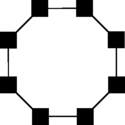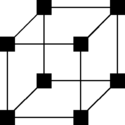Octophonic sound
| Typical octophonic arrangements |
|---|
| 8 speakers spaced on a circle by 45°, first speaker 0°. |
| 8 speakers spaced on a circle by 45°, first speaker 22.5°. |
| 8 speakers spaced on the vertices of a cube. |
|
Octophonic sound is a form of audio reproduction that presents eight discrete audio channels using eight speakers. For playback, the speakers may be positioned in a circle around the listeners or in any other configuration. "Typical arrangements are eight spaced on a circle by 45° (oriented with first speaker 0° or at 22.5°), or the vertices of a cube to bring in a double quadraphonic set-up with elevation" (Collins 2010, 60). In reference to his own work, Karlheinz Stockhausen made a distinction between these two forms, reserving the term "octophonic" for the arrangement in a cube, as found in his Oktophonie and the electronic music for scene 2 and the Farewell of Mittwoch aus Licht, and using the expression "eight-channel sound" for the circular arrangement, as used in Sirius, Unsichtbare Chöre, or Hours 13 to 21 of the Klang cycle (Stockhausen 1993, 150; Stockhausen 2000, 60). While quadraphonic sound uses four speakers positioned in a square at the four corners of the listening space (either on the ground or raised above the listeners), this cubical kind of octophonic spatialization allows not only front-back and left-right "surround sound", but also up-down and diagonal movements—a 3D spatialization of sound. In order for such movement in space to be heard, it is necessary that rhythms be slow, and pitches change mainly in small steps or in glissandos (Stockhausen 1993, 151, 163).
Composers who have worked in octophonic sound include Karlheinz Stockhausen, Jonathan Harvey, Gérard Pape, and Larry Austin. The first known octophonic (that is, eight-channel) electronic music was John Cage's Williams Mix (1951–53) for eight separate simultaneously played back quarter-inch magnetic tapes (Collins 2010, 26; Leider 2004, 290). Austin later made a surround-sound octophonic mix of Williams Mix, Williams (re)Mix[ed] (1997–2000), using the score and different sound sources (Austin 2004, 189). This version is intended to be played back on eight speakers surrounding the audience in a 360° circle, using (unlike Cage's original version) stereo source recordings heard in adjacent speaker pairs (Austin 2004, 205, 207). Octophonic sound (in the general sense of eight-channel playback) was stimulated primarily by "the equal coverage it provides to all listening angles" and also by the precedence of eight-channel (initially tape) sound and subsequent ease of playback (Leider 2004, 290).
See also
References
- Austin, Larry. 2004. "John Cage's Williams Mix (1951–3): The Restoration and New Realisations of and Variations on the First Octophonic, Surround-Sound Tape Composition". In A Handbook to Twentieth-Century Musical Sketches, edited by Patricia Hall and Friedemann Sallis, 189–213. Cambridge and New York: Cambridge University Press. ISBN 978-0-521-80860-6.
- Collins, Nicholas. 2010. Introduction to Computer Music. Chichester: John Wiley. ISBN 978-0-470-71455-3.
- Leider, Colby. 2004. Digital Audio Workstation. New York: McGraw-Hill. ISBN 978-0-07-142286-4.
- Stockhausen, Karlheinz. 1993. "Octophony: Electronic Music from Tuesday from Light", translated by Jerome Kohl. Perspectives of New Music 31, no. 2 (Summer): 150–70.
- Stockhausen, Karlheinz. 2000. "Neue Raum-Musik: OKTOPHONIE". In Komposition und Musikwissenschaft im Dialog I (1997–1998) , edited by Imke Misch and Christoph von Blumröder, 60–77. Signale aus Köln: Musik der Zeit 3. Saarbrücken: Pfau-Verlag. ISBN 3-89727-049-8.
|
|---|
|
| People | | |
|---|
|
| Compositions | |
|---|
|
| Techniques | |
|---|
|
| Instruments | |
|---|
|
Inactive
organizations | |
|---|
|
Active
organizations | |
|---|



